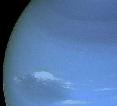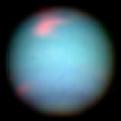NEPTUNE: The fastest winds in the Solar System
 After the rather boring and disappointing images came back from Voyager 2 of
Uranus, scientists where quite excited in 1989 when Voyager returned much more
interesting images of Neptune's atmosphere! Several hurricane-like spots
where found, similar to Jupiter and Saturn, and wind speeds were clocked
at up to 1300 mph!
After the rather boring and disappointing images came back from Voyager 2 of
Uranus, scientists where quite excited in 1989 when Voyager returned much more
interesting images of Neptune's atmosphere! Several hurricane-like spots
where found, similar to Jupiter and Saturn, and wind speeds were clocked
at up to 1300 mph!
Neptune's Atmosphere
At the time of the Voyager encounter, Neptune's most prominent feature
was the Great Dark Spot in the southern hemisphere, about half
the size as Jupiter's Great Red Spot (and about the size of Earth).
Neptune's winds blew the Great Dark Spot westward at 300 meters/second
(700 mph). Voyager 2 also saw a smaller dark spot in the
southern hemisphere and a small irregular white cloud that
zips around Neptune every 16 hours or so now known as
"The Scooter". It may be a plume rising from lower in
the atmosphere but its true nature remains a mystery.
HST observations of Neptune in 1994 show that the Great
Dark Spot has disappeared. Neptune's atmosphere changes
rapidly, perhaps due to slight changes in the temperature
differences between the tops and bottoms of the clouds.
Like Jupiter and Saturn, Neptune has an internal heat source -- it radiates more than twice as much energy as it receives from the Sun. This source on internal heat is what drives the winds, hurricanes and bands seen in all three planets: Jupiter, Saturn and Neptune. It is called thermally driven buoyant convection. Note that Uranus does not appear to have an internal heat source and this is likely the reason for its rather boring atmospheric nature.
Neptune's composition is probably similar to Uranus': various "ices" and rock with about 15% hydrogen and a little helium. Like Uranus, but unlike Jupiter and Saturn, it may not have a distinct internal layering but rather to be more or less uniform in composition. But there is most likely a small core (about the mass of the Earth) of rocky material. Its atmosphere is mostly hydrogen and helium with a small amount of methane, about 3% compared to Uranus' 2%, which gives Neptune its darker blue color (methane absorbs the red light very effectively).
The Magnetic Field
Both Neptune and Uranus have rather weak, strangely aligned magnetic
fields. This tells us there must be some kind of
conducting fluid material beneath their surfaces. For Jupiter and
Saturn, it's their outer core of metallic liquid hydrogen. However,
for Uranus and Neptune, its probably liquid water (with dissolved
ammonia---pure water is a poor conductor!) in its mid-layers.
Planet rotation then drives the dynamo
effect to generate the magnetic fields.
Finding the Planets
All planets we've talked about thus far can be found with the
naked eye (Mercury, Venus, Mars, Jupiter, Saturn) or with
binoculars (Uranus and Neptune). However, you'll need to know where
to look! There are several Web sites that show the current position
of the other planets in the sky (click HERE). More detailed charts will be required to find Uranus
and Neptune. Such
charts can be created with a planetarium program (click HERE).
